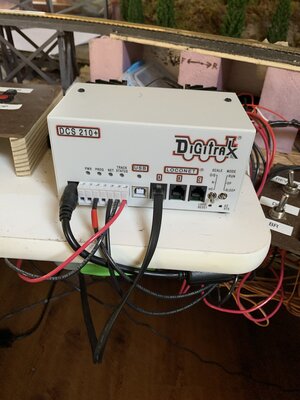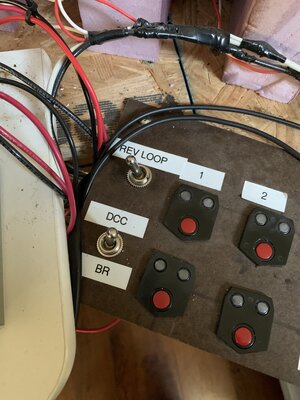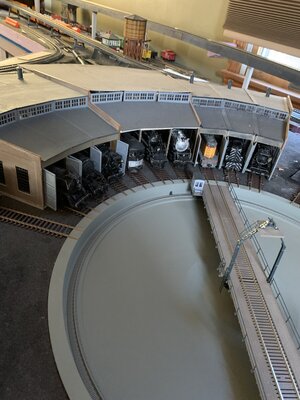I'm new to DCC and building a small n scale layout. I've bought a few DCC equipped locos and one DC version I will convert to DCC at some point. I also have a DigiTrax ZEPHYR DCS52 for the DCC part. I understand that DCC puts a constant 14 - 16V on the rails but one DC loco can also be run with a separate DC power supply. I suspect that the variable DC is superimposed on the rails along with the constant AC voltage but the question is - what is the effect on the DC loco with that constant AC voltage always present?
You are using an out of date browser. It may not display this or other websites correctly.
You should upgrade or use an alternative browser.
You should upgrade or use an alternative browser.
Operating a DC loco on a DCC layout
- Thread starter rreitz
- Start date
ModelRailroadForums.com is a free Model Railroad Discussion Forum and photo gallery. We cover all scales and sizes of model railroads. Online since 2002, it's one of the oldest and largest model railroad forums on the web. Whether you're a master model railroader or just getting started, you'll find something of interest here.

Affiliate Disclosure: We may receive a commision from some of the links and ads shown on this website (Learn More Here)
Not quite.
On some DCC systems, you can run a DC engine on address 0. DCC puts a pulsed constant voltage in the rails and by varying the pulses it can "trick" a DC engine into thinking its on DC. However, it can also damage the DC motor in the engine. That's why some DCC systems don't allow using address 0 to run a DC engine.
If you hook up a DC power supply to a layout with an operating DCC system, something is going to fry.
The only way to hook up a DC system is to add block toggles that switch between DC and DCC in sections of the layout.
On some DCC systems, you can run a DC engine on address 0. DCC puts a pulsed constant voltage in the rails and by varying the pulses it can "trick" a DC engine into thinking its on DC. However, it can also damage the DC motor in the engine. That's why some DCC systems don't allow using address 0 to run a DC engine.
If you hook up a DC power supply to a layout with an operating DCC system, something is going to fry.
The only way to hook up a DC system is to add block toggles that switch between DC and DCC in sections of the layout.
I believe DigiTrax has a method to allow 1 DC loco to be run on their DCC system using the address 00 (double zero) but no other brand does that. Whether that means along with DCC locos at the same time, can't say, but it sounds illogical. DCC is not your normal house type AC current either. That has a round top and bottom like the waves of the Sea. DCC current is a rectangular wave with straight vertical sides and horizontal tops and bottoms. The lengths of the tops and bottoms are what carry the digital signal and they vary according to what the signal is. The decoder in the engine unscrambles them.
timlange3
Active Member
You should be able to run any modern, reasonable cost DC loco on DCC at address 0. Electrical can motors do better than open frame motors. Don't let the loco sit on the rails with power very long, it will heat up. Actual running (with motor spinning) should be good for as long as you want. From my experience you will get tired of isolating the loco when not in use, converting to DCC is the best solution.
Selector
Well-Known Member
Every drive mechanism is different, but I have a very nice Proto 2000 0-8-0 that I purchased as a DC model, expecting to convert it to DCC. Before I converted it, I ran it on a whim in DC on my Digitrax Super Empire Builder system. It ran. That's about all the good I can say about my experience, this solitary venture. Only that one locomotive, and it may not have been representative of everyone's experience who has ever tried this. But in my case, it was not what I would call a salutary experience. The drive groaned, moaned, whined, gritted, whinged, and generally sounded like a wounded and scared cat. Did I say the locomotive moved? Well, it did....but.......
The problem is the zero stretching component of the DCC square wave. You're using a pneumatic engine to run a car, and it ain't pretty. The car will move, but there won't be any happy faces inside. If you follow. The drive mechanism is strictly DC, even in our DCC locomotives. The decoder meters out DC to the motor after rectifying the digital AC current it gets from the rails. But if you attempt to run a DC locomotive, no decoder, with that weird '00' address, the motor will get some zero stretching, and it will sing and grind when it does.
Not good, not in my one attempt 16 years ago.
The problem is the zero stretching component of the DCC square wave. You're using a pneumatic engine to run a car, and it ain't pretty. The car will move, but there won't be any happy faces inside. If you follow. The drive mechanism is strictly DC, even in our DCC locomotives. The decoder meters out DC to the motor after rectifying the digital AC current it gets from the rails. But if you attempt to run a DC locomotive, no decoder, with that weird '00' address, the motor will get some zero stretching, and it will sing and grind when it does.
Not good, not in my one attempt 16 years ago.
Thanks for the inputs. I'll just use the pure DC setup for checking out the track and only use DCC with DCC equipped loco's then. I did buy a DCC chip for the DC loco just haven't attempted to install it yet. This is a DC Atlas SW2 with a separately purchased DigiTrax decoder. From what I have read it is a simple matter of pulling out the DC IC and plugging in the DCC IC. The hardest part will be removing the hood and cab to get at the chip.
Smudge617
Well-Known Member
I have the same controller as you, I don't run a DC loco with it (even though we can) as it can harm the motor if it stands still too long, also as previously stated, poor performance and a constant buzzing noise gets annoying very quickly, fit the chip and your away. I would suggest fitting some track to a separate board that you can connect to DC, very handy for initial testing of a non DCC fitted Loco and fault finding, mines also separately wired up for Decoder programming as well, away from the layout.Thanks for the inputs. I'll just use the pure DC setup for checking out the track and only use DCC with DCC equipped loco's then. I did buy a DCC chip for the DC loco just haven't attempted to install it yet. This is a DC Atlas SW2 with a separately purchased DigiTrax decoder. From what I have read it is a simple matter of pulling out the DC IC and plugging in the DCC IC. The hardest part will be removing the hood and cab to get at the chip.
trailrider
Well-Known Member
I have a LOT of older DC locomotives, some steam, some diesel, dating back as far as 67 years...too many to convert, both timewise and cost. I also have a number of DCC engines, four of which I converted to DCC. As I started my current layout in DC, with blocks, and only started with DCC about 3 years ago to get some sound. Since I am only one person, I only run one engine at a time, storing others on yard tracks, etc. My solution is having a power pack for each, with a master toggle switch on my main control panel to select either DC or DCC, but not both at the same time. Especially with the older open-frame motors, attempting to run a DC engine on DCC will result in burning out the DC motor sooner or later.
If all you have is one DC engine, I'd suggest converting it to DCC.
If all you have is one DC engine, I'd suggest converting it to DCC.
Yes - I did buy a separate decoder but haven't installed it yet. I'm still hand laying the code 40 rail and like to check out the progress in stages using the DC controller first to work out the bugs. Once all the rail is installed and checked out I will then convert the odd one to DCC. Like I said above the hardest part will be getting the parts off to get access to the plug in. Thanks for all the inputs.Since basic decoders are available for less than $20.00 why not just convert it? If it’s plug and play should take you all of 5 minutes. As has been said the “Zero stretching” function is hard on motors and performance is poor when it’s used.
if, IF you only have but one DC (analog) loco and the others are DCC, why bother to take a chance frying any DCCers just to run the one DCer ?!
Build your N scale road. Run the DCCers with your DigTRx throttle and fuggeddaboudit !! Convert the one DCer to DCC first and add it to the road later on..





Build your N scale road. Run the DCCers with your DigTRx throttle and fuggeddaboudit !! Convert the one DCer to DCC first and add it to the road later on..
Last edited:
So, what are you saying ? You want to power the track with analog DC, run the (what?) few DCCers and the DCer on the same track, the DCCers in DC mode ? What ?
Again, if you own a number of DCC locos, seemingly because one is still an analog loco, is it that you want to run them all analog ? Or, is it you intend to connect both analog and digital throttles to the track and volley between the two ?
if, IF that is so, you're looking for trouble..The 2 throttles must first be segregated with a toggle so that only 1 can be on at any given time...
But still, if you have DCC locos on the track in DCC mode and you turn the analog controller on you'll fry them if they aren't IN DC mode first...
So, again, why not just leave the 1 analog engine out of the picture, lay and energize the track using the DCC controller, run the DCCers only, and convert the 1 analog engine to digital later when you have time since your final system will be DCC anyway ? Or am I misunderstanding ? ....
....
Again, if you own a number of DCC locos, seemingly because one is still an analog loco, is it that you want to run them all analog ? Or, is it you intend to connect both analog and digital throttles to the track and volley between the two ?
if, IF that is so, you're looking for trouble..The 2 throttles must first be segregated with a toggle so that only 1 can be on at any given time...
But still, if you have DCC locos on the track in DCC mode and you turn the analog controller on you'll fry them if they aren't IN DC mode first...
So, again, why not just leave the 1 analog engine out of the picture, lay and energize the track using the DCC controller, run the DCCers only, and convert the 1 analog engine to digital later when you have time since your final system will be DCC anyway ? Or am I misunderstanding ?
Yes. you have it correct! DC loco on DC setup only and no DCC in the picture at all! After things are working good then DCC loco's on DCC (with DC loco converted to DCC). No mix and match in either case. Not sure how this got so convolutedI believe the take away from all this is if we run dc on dc and dcc on dcc, can’t go wrong. And then there’s railpro…whole nuther topic!
Smudge617
Well-Known Member
If you have a lot of older DC loco's as you say, then at some point you may want to convert them to DCC as you have far more control of them especially at slower speeds (for shunting/switching etc.) And your unlikely to find all the bugs on the track, except maybe where you have track joins and possible derailment spots as DCC runs on different electrical impulses so it's far more sensitive to any track imperfections than DC.Yes. you have it correct! DC loco on DC setup only and no DCC in the picture at all! After things are working good then DCC loco's on DCC (with DC loco converted to DCC). No mix and match in either case. Not sure how this got so convoluted
Here is my power supply:

Here is my double pole double throw center off

these are some of my locos some are dc and some are dcc

when I run a dc loco, I flip the 2 pole switch to BR. BR means BlueRail which is a small circuit board which connects to a Tsunami 2 steam with speakers and on to the track. The speakers are sitting next to my Digitrax . I can run 1 dc loco at a time on the layout with sound…. With no whining or fear of motor damage controlling with my IPhone. When I run dcc locos, I flip the 2 pole switch to the dcc side and run dcc locos as normal… I have run as many as five but I usually only run 1 or 2 at a time. I am gradually installing decoders in my older locos and will eventually phase out the BR board, but for now this works well.

Here is my double pole double throw center off

these are some of my locos some are dc and some are dcc

when I run a dc loco, I flip the 2 pole switch to BR. BR means BlueRail which is a small circuit board which connects to a Tsunami 2 steam with speakers and on to the track. The speakers are sitting next to my Digitrax . I can run 1 dc loco at a time on the layout with sound…. With no whining or fear of motor damage controlling with my IPhone. When I run dcc locos, I flip the 2 pole switch to the dcc side and run dcc locos as normal… I have run as many as five but I usually only run 1 or 2 at a time. I am gradually installing decoders in my older locos and will eventually phase out the BR board, but for now this works well.
Affiliate Disclosure: We may receive a commision from some of the links and ads shown on this website (Learn More Here)

